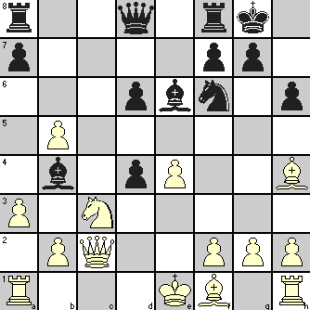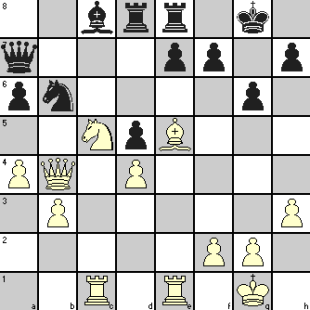Continuing with our theme in Beginners may take heart from these games, we bring three more games where a player rated much lower than his opponent shows that how you play over the board is more important than what elo rating you hold.
At the time the first game (Fouts-Firman, Philadelphia, 2003) was played, White’s elo rating was about 800 points less than Black’s. But that did not daunt him and he kept on seizing the initiative at every step. White had to capitualate ultimately under the relentless pressure.
The figure below shows the position after 20 moves.
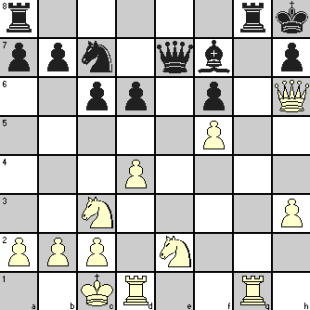
| 21. | Ne4 | Nd5 | |||
| 22. | Nf4 | Nxf4 | |||
| 23. | Nxf6 | Bh5 | |||
| 24. | Nxg8 | Rxg8 | |||
| 25. | Rxg8+ | Kxg8 | |||
| 26. | Rg1+ | Ng6 | |||
| 27. | Kb1 | Resigns | A quiet move after some hectic activities! But it raises the threat 28. Qxh5 besides the inevitable capture of the Knight. |
The following position was reached after 14 moves in the game (Spielmann-Van den Bosch, 1935). Johannes Van den Bosch is relatively unknown whereas you must have heard of Rudolf Spielmann as one of the best chess tacticians ever. But here the master tactician gets outsmarted pretty thoroughly!
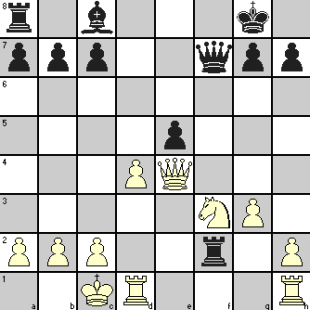
| 15. | Nf3 | Qf7 | Black threatens 16. … Qxa2 with mate to follow. | ||
| 16. | Ng5 | Bf5 | |||
| 17. | Qxb7 | Rxc2+ | |||
| 18. | Kb1 | Rc1+ | After White’s 18th move, Black seemed to be heading for trouble as both his Queen and Rook are under attack. But his reply shows the power of double check which dooms White now as the subsequent moves are almost forcing on White. | ||
| 19. | Kxc1 | Qc4+ | |||
| 20. | Kd2 | Qd3+ | |||
| 21. | Ke1 | Qe3+ | |||
| 22. | Kf1 | Rf8 |
White resigned as he has no adequate defense to the threat of 23. … Bh3#. Both 23. Qb3+ Be6+ and 23. Kg2 Qe2+ 24. Kg1 Be6 lead to mate.
The next game (Tarrasch-Yates, Hamburg, 1910) had a piquant background. It seems that Dr. Tarrasch, a stalwart of his time, objected to the entry of Yates in that tournament considering him to be below par in comparison to other participants. Yates had only one win in that tournament but he possibly kept it in reserve as a fitting reply to his redoubtable opponent!
The position after 18 moves stands as below.
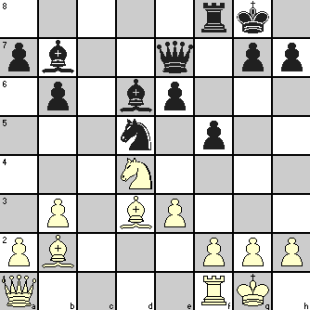
| 19. | Rc1 | Nxe3 | This sacrifice turns the game in favor of Black. |
||
| 20. | fxe3 | Qg5 | Black threatens 21. … Qxg2# or 21. … Qxe3+ with a strong attack in coordination with his Bishop pair. | ||
| 21. | Kf2 | Qxg2+ | |||
| 22. | Ke1 | Bxh2 | Black has got three pawns for his Knight, an adequate compensation, besides ruining White’s castle and opening lines for his Bishops. White cannot play 23. Nxe6 because of 23. … Bg3+ 24. Kd1 Bf3+ leading to mate. | ||
| 23. | Be2 | e5 | |||
| 24. | Ne6 | Bg3+ | |||
| 25. | Kd1 | Bf3 | |||
| 26. | Bxf3 | Qxf3+ | |||
| 27. | Kc2 | Qe4+ | |||
| 28. | Kd2 | Qd5+ | |||
| 29. | Nd4 | exd4 | |||
| 30. | Bxd4 | f4 | |||
| 31. | e4 | Qxe4 | |||
| 32. | Rc4 | Rd8 | Black’s move puts paid to all hopes of White for saving the Bishop due to coming 33. … Bf2 | ||
| 33. | a4 | Bf2 |
White resigned as he cannot avoid losing his Bishop and the game.
The final position:
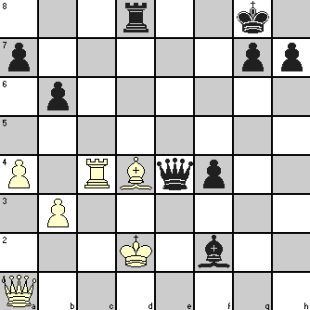
Do you still have doubt in yourself?
